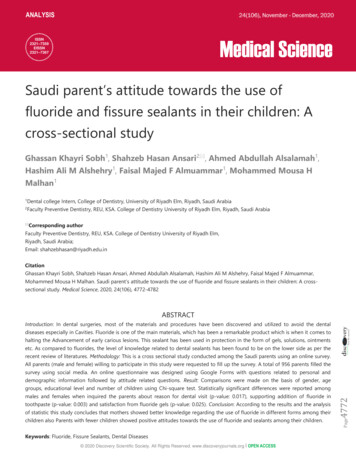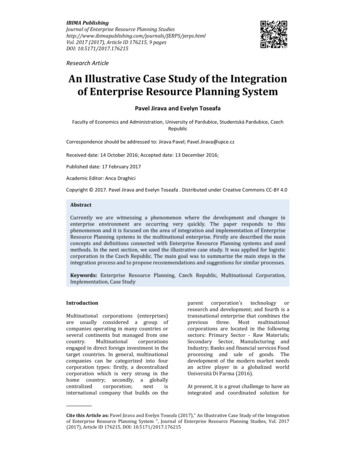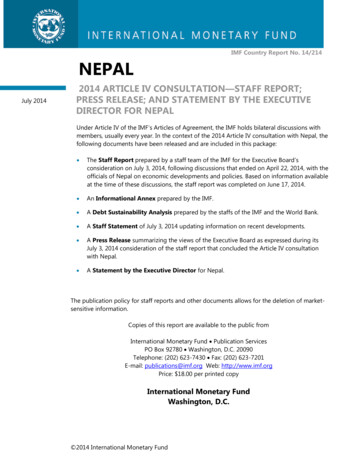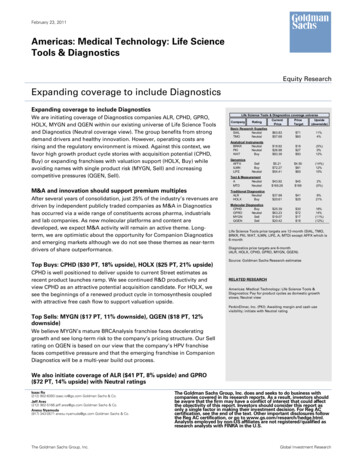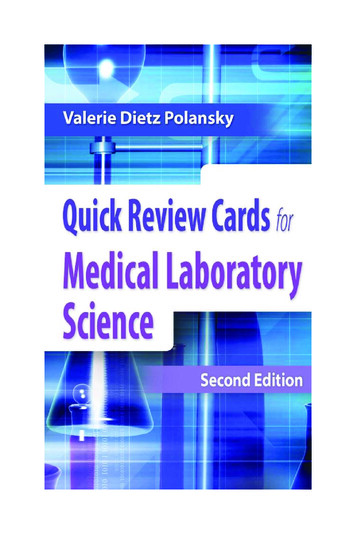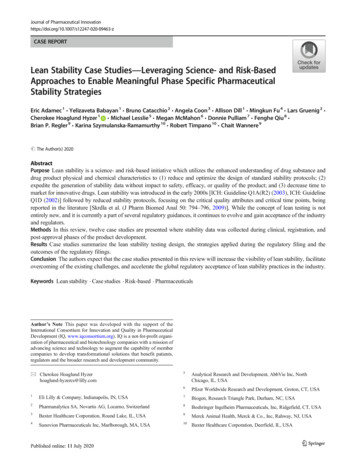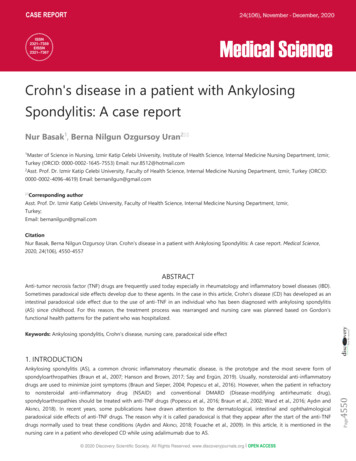
Transcription
CASEANALYSISREPORT24(106), November - December, 2020ARTICLEMedical ScienceISSN2321–7359EISSN2321–7367Crohn's disease in a patient with AnkylosingSpondylitis: A case reportNur Basak1, Berna Nilgun Ozgursoy Uran2 1Masterof Science in Nursing, Izmir Katip Celebi University, Institute of Health Science, Internal Medicine Nursing Department, Izmir,Turkey (ORCID: 0000-0002-1645-7553) Email: nur.8512@hotmail.com2Asst.Prof. Dr. Izmir Katip Celebi University, Faculty of Health Science, Internal Medicine Nursing Department, Izmir, Turkey (ORCID:0000-0002-4096-4619) Email: bernanilgun@gmail.comCorresponding author Asst. Prof. Dr. Izmir Katip Celebi University, Faculty of Health Science, Internal Medicine Nursing Department, Izmir,Turkey;Email: bernanilgun@gmail.comCitationNur Basak, Berna Nilgun Ozgursoy Uran. Crohn's disease in a patient with Ankylosing Spondylitis: A case report. Medical Science,2020, 24(106), 4550-4557ABSTRACTAnti-tumor necrosis factor (TNF) drugs are frequently used today especially in rheumatology and inflammatory bowel diseases (IBD).Sometimes paradoxical side effects develop due to these agents. In the case in this article, Crohn's disease (CD) has developed as anintestinal paradoxical side effect due to the use of anti-TNF in an individual who has been diagnosed with ankylosing spondylitis(AS) since childhood. For this reason, the treatment process was rearranged and nursing care was planned based on Gordon'sfunctional health patterns for the patient who was hospitalized.Keywords: Ankylosing spondylitis, Crohn’s disease, nursing care, paradoxical side effect1. INTRODUCTIONAnkylosing spondylitis (AS), a common chronic inflammatory rheumatic disease, is the prototype and the most severe form ofspondyloarthropathies (Braun et al., 2007; Hanson and Brown, 2017; Say and Ergün, 2019). Usually, nonsteroidal anti-inflammatorydrugs are used to minimize joint symptoms (Braun and Sieper, 2004; Popescu et al., 2016). However, when the patient in cı, 2018). In recent years, some publications have drawn attention to the dermatological, intestinal and ophthalmologicalparadoxical side effects of anti-TNF drugs. The reason why it is called paradoxical is that they appear after the start of the anti-TNFdrugs normally used to treat these conditions (Aydın and Akıncı, 2018; Fouache et al., 2009). In this article, it is mentioned in thenursing care in a patient who developed CD while using adalimumab due to AS. 2020 Discovery Scientific Society. All Rights Reserved. www.discoveryjournals.org l OPEN ACCESS4550nonsteroidalspondyloarthropathies should be treated with anti-TNF drugs (Popescu et al., 2016; Braun et al., 2002; Ward et al., 2016; Aydın andPageto
CASE REPORTARTICLE2. CASE REPORTAdalimumab (ADA) treatment was started 9 years ago in a 29-year-old male patient, who has been treated with an AS diagnosissince childhood. The patient who did not have any gastrointestinal disease in the family history applied to the emergencydepartment with complaints of severe abdominal pain, bloody diarrhea, weight loss, severe weakness, and fatigue. In the patientwhose ADA treatment was discontinued, emergency colonoscopy, MR and DX were performed when weight loss and fatigueincreased, and he was referred to the service with suspicion of CD due to fibrotic stenosis in the descending colon (Figure 1a-b).Figure 1a The MR images of patient’s.Figure 1b The abdominal CT images of patient’s.The patient who was known to have a familial Mediterranean fever (FMF) and gastritis other than AS, in addition to the existingsymptoms, joint pain, nausea, and vomiting were also observed. In the physical examination of the patient whose emergencymalnutrition was started, immobilization due to bilateral hip attitude, extension loss in the knee due to inappropriate posture,tenderness in the lower left quadrant and 37.8oC fever were observed. The results of the examinations are as follows; sedimentation:75 mm / h leukocyte: 8.500 K/µL, hemoglobin (Hb): 8.8 g/dL, platelet (PLT): 1564.000 K/µL, C-reactive protein (CRP): 22.86 mg/dL (N 0, 8), total protein: 6.8 g/dL, albumin: 3.3 g/dL, iron: 30 ug/dL, iron binding capacity: 110 ug/dL, ferritin: 437 ug/L. The patient's vitalsigns were measured as breathing 18 / min, body temperature 37.8oC, blood pressure 109/62 mmHg, pulse 110 / min, and thepatient has a 14.5 body mass index (BMI) with 37 kg and 160 cm in height.Nutritional Risk Screening-2002 which is developed by the European Society of Parenteral and Enteral Nutrition (ESPEN) in 2002gave score 5 as a result (N score 3). 1x1 200 ml nutrition support was applied to the patient in addition to applying a calorie dietbecause he has a low body mass index. Also, the patient was given 1x1 250 mg vitamin B12, 1x1 5 mg folic acid, 1x1 1.25 mg (15drops) vitamin d supplements. The common treatment plan for the patient's known AS, FMF, gastritis and CD diseases are as follows;1x1 40 mg pantoprazole, 2x2 500 mg sulfasalazine, 3x1 0.5 mg colchicum, 2x1 750 mg NSAID.CD paradoxically during the use of ADA, treatment was planned to continue with infliximab and was discharged by recommendingpolyclinic control. 2020 Discovery Scientific Society. All Rights Reserved. www.discoveryjournals.org l OPEN ACCESSPagetreatment. It was planned to start anti-TNF treatment after discontinuation of steroid therapy. However, due to the development of4551Premedication was performed with 40 mg prednisolone for 3 days to the patient who gave results with PPD: 0 mm. To the risk ofdeveloping tuberculosis, 300 mg isoniazid was started 3 weeks before the anti-TNF application was started as a preventive
ARTICLECASE REPORTEvaluation of the Case According to Gordon's Functional Health PatternsIn his work on nursing diagnoses in 1987, Gordon proposed a perspective called "Functional Health Patterns (FHP)" to gather andorganize information with a strong nursing perspective. FHP nursing process, which Gordon defines as the order of behaviors in acertain period of time, emphasizes critical thinking and clinical decision making. FHP has been classified under 11 headings relatedto human health and life process. These are health perception and health management, nutrition-metabolic status, excretory,activity-exercise, cognitive-perceptual, sleep-rest, self-recognized, role and relationships, sexuality-reproduction, coping-stresstolerance, value-belief patterns (Staub-Müler, 2009; Erdemir and Yılmaz, 2003; Erdemir and Yılmaz, 2003).When the patient came to the service, he was nervous because of a disease that developed in addition to his existing diseases.Expressing that he did not know about the CD, the patient said that he was anxious and afraid. The patient with cigarette andalcohol consumption, although it is canning a cause for complications for his existing diseases, said that he worked as a courier in acompany. Constipation developed in the patient due to limited mobilization, malnutrition, and immobility. The patient has painwhich causes multiple drug use, autoimmune disease and gastritis and the pain was measured as 5.5 according to the visual analogscale (VAS). The results of some specific tests applied to the patient because he has AS are as follows; bath ankylosing spondylitisdisease activity index (BASDAI) is 5.2 and bath ankylosing spondylitis functional index (BASFI) is 8.1.Nursing diagnoses and interventions determined according to the factors mentioned above are given in the table (Table 1)(Figure 2).Table 1 Nursing Diagnoses According to Gordon's FHPGordon’sNursingFHP HeadersDiagnosisInterventionsResults- Factors that could cause the patient to fall wereevaluated.- The risk of falling of the patient was evaluated.The patient didthe patient were placed near him.not fall during the- While the patient was in his bed, the bed edgingscare process. Thewere elevated.goal has been- The patient was informed about orthostaticachieved.hypotension.-The walking area would be checked for security andremoved in case of an obstacle.- The subjects in which the patient's lack ofinformation, were identified.diseases' information.The patient stated- The effect of maintaining a healthy diet onthat he wouldautoimmune diseases was mentioned.comply with theIneffectiveness- It was mentioned that the harmful effects ofrecommendationsin Maintainingsubstance use on health and increase the incidencegiven and that heHealthof complications in diseases.would contact the- The patient was informed about the treatmentsocial health linesprocesses.in the parts where- The patient was encouraged to change his lifestylehe had difficulty.(diet, exercise, sleep, and career choice).- The effect of oral hygiene on health and systemswas mentioned. 2020 Discovery Scientific Society. All Rights Reserved. www.discoveryjournals.org l OPEN ACCESS4552- The patient was educated on the deficiencies ofPageHealth Perception and Health ManagementRisk for Falls- The products that will provide the basic needs of
ARTICLECASE REPORTNutrition-Metabolic Status-The daily calorie needs of the patient wereNutritionalImbalance:Less thanRequireddetermined by discussing with the dietician.Weight: 38 kg-The importance of adequate nutrition wasLength: 160 cmexplained.Waist-The individual feeding status of the individual wasCircumference: 55evaluated.cm-Foods that increase nausea were determined andBMI: 14.84 kg /fluid intake between foods was restricted.m2-Small and frequent feeding was recommended.NRS-2002: 4-The importance of preferring high protein foodsThe patient'swas explained.condition is- BMI was calculated by daily weight follow-up.stable. The-The importance of using the prescribed fooddiagnosissupplements when the patient could not meet thecontinues.required daily calories was explained.The patient's-It was supported by feeding the fiber if there is noobstacle to the patient's diet.- The patient was provided to take at least 2 liters offluid daily.Excretory- The positive effect of drinking a warm glass ofwater when the patient woke up in the morning wasConstipationmentioned to him.- Practices that facilitate defecation were taught(gently massaging the abdomen, semi-squattingsitting, etc.).-Told about the importance of exercising to thepatient, he was supported to walk during the day.-The patient was followed up for symptoms of vagalstimulation (dizziness, pulse drop).bowel soundswere auscultatedas 4 minutes inthe upper right, 4in the upper left,3 in the lower left,and 4 in the lowerright.100 mg laxativewas applied tothe patient.The patient wasable to defecate.Vagal stimulationwas not observedin the process.During the periodImpairedPhysicalMobility:Disruption ofWalking- The patient was trained in safe ambulation.- Safe use of the ambulation aid (like a walker) wasensured and the patient was followed up for correctuse.- Support was given to improve the patient'smobilization.- Appropriate interventions were applied to thepatient in terms of the risk of falling.improvementswere observed inthe patient'smobilization.Physiotherapistsupport wasprovided.New BASDAIscore was 3,7 andBASFI score wasPerceptualCognitive-6,4.No problem wasDeficient-The patient was evaluated in terms of learning anddetected in theKnowledgeconcentration capacity.learning level and-The best learning method of the patient wasconcentration 2020 Discovery Scientific Society. All Rights Reserved. www.discoveryjournals.org l OPEN ACCESS4553Activity-Exerciseof a physiotherapist.of care,Page- Walking problem was evaluated with the support
CASE REPORTARTICLEdetermined.capacity of the-The subjects that the patient is missing and knowspatient. Goalsincorrectly were determined.were achieved as- The emotional and cognitive status of the patienta result of thefor education was planned for the best time.initiatives. The-The patient was informed about new diagnosespatient was(CD), existing chronic diseases (anemia, AS).referred to the- Information was given about the specific treatmenttraining nurse for(anti-TNF drugs) applied to the patient.more detailed-It was supported by using brochures in thetraining.information given to the patient.-The questions left in the patient's mind wereanswered.Acute Pain- The cause of the pain was determined andWidespread 5.5-explained to the patient.throbbing and- The type, spread, and extent of pain werecramp-type paindetermined.in the lower left- The patient was observed in terms of physiologicaland upperpain symptoms. (Tachycardia, sweating, etc.)quadrants.- Non-pharmacological methods (drawing attentionNon-to another direction, entanglement, breathingpharmacologicalexercises, reading books, massage, hot/coldmethods wereapplication, etc.) were applied by determining theapplied. (VAS: 4.5)factors that reduce and increase pain.VAS score is 3- The patient was given the opportunity to restafter appliedduring the day.analgesic.The level of fearbefore thetraining wasSelf-RecognizedFear- The cause of the fear in the patient wasmeasured as 6.9 /determined.10. After the- The degree of fear was evaluated.training, the fear- The questions causing the fear were answered onelevel of theby one for the patient was relaxed.patient was- The patient will be given the opportunity tomeasured as 5.4 /express his feelings and encouraged.10 with the same- Relaxation methods such as deep breathing,questionnaire.meditation, yoga, etc. that can reduce the fear of theThe patient's fearpatient were taught.which is occurredfrom the lack ofinformation wasFatiguecausing it were determined.- Patient and patient relatives were informed interms of energy conservation methods. (PlacingThe patient'sfatigue problemcontinues.things nearby, being able to regulate breathing, 2020 Discovery Scientific Society. All Rights Reserved. www.discoveryjournals.org l OPEN ACCESSPage- The degree of the patient's fatigue and the factors4554removed.
CASE REPORTARTICLEdetermining the time when it is en
Evaluation of the Case According to Gordon's Functional Health Patterns In his work on nursing diagnoses in 1987, Gordon proposed a perspective called "Functional Health Patterns (FHP)" to gather and organize information with a strong nursing perspective. FHP nursing process, which Gordon defines as the order of behaviors in a
